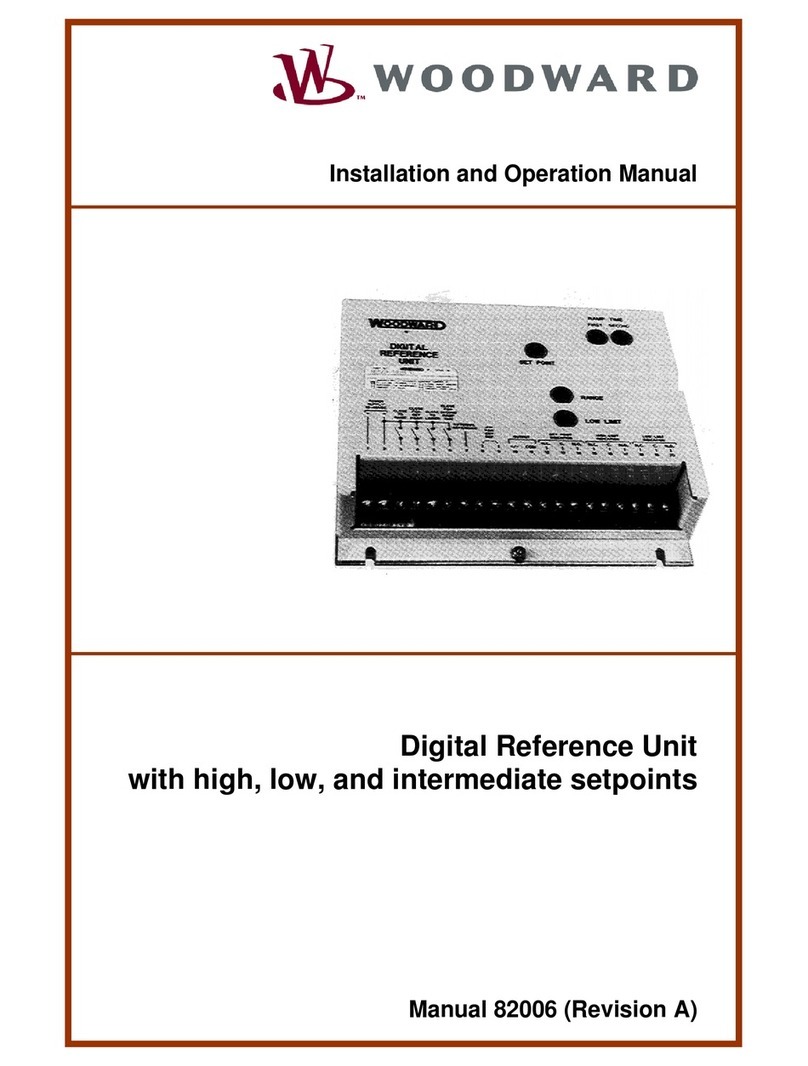
Manual 03108 3161 Air Pressure Fuel Limiter
Woodward 3
Chapter 2.
Principles of Operation
The Air Pressure Fuel Limiter is designed to allow adjustment to permit full fuel or
fuel limiting to the engine during cranking and start-up. If the adjustment has
been made for full fuel, the fuel limiter is inoperative until the engine has started
(see Figure 2-1).
If the limiter has been adjusted for full fuel on start-up, as speed or load is
increased to the prime mover, air pressure increases, raising the rolling
diaphragm assembly, compressing the limiter spring. As the rolling diaphragm
assembly moves up, the fuel limit plunger also moves up and closes off the port
in the limiter piston, trapping the supply oil. The trapped oil increases in pressure
until it is high enough to overcome the limiter spring and push the limiter piston
down. The lower edge of the fuel limit plunger uncovers the port in the limiter
piston, allowing supply oil to go to drain. The limiter is now “armed” and
operational.
If the limiter is calibrated to limit fuel on start-up, the arming adjustment screw
has been backed out (turned counterclockwise) to allow the fuel limit plunger to
move up and close off the port in the limiter piston, trapping the supply oil. The
trapped oil increases in pressure until it is high enough to overcome the limiter
spring and push the limiter piston, limiter output rod, limit lever, limit rod, and
limit/shutdown pilot valve plunger down. When the limit/shutdown pilot valve
moves down, governor control oil is allowed to drain back to sump, thus limiting
fuel.
If additional load is applied and pressure from the air manifold is increased
further, the rolling diaphragm assembly again moves up, raising the fuel limit
plunger. Pressure on the limiter piston drops due to the opening of the port, and
the limiter piston moves up until the port is closed again. As described, limiter
piston position is proportional to air manifold pressure.
The limit/shutdown pilot valve is activated through the action of the
limit/shutdown rod, limit rod, limit floating lever, limiter cam, limit lever, and limiter
output rod.
The limit range is determined by the positioning of the limit cam on the limit lever.
Moving the cam away from the shutdown rod lengthens the limiting range, and
moving it closer to the shutdown rod shortens the limiting range.
Assume the prime mover is running on speed with the limiter armed. Load is
applied to the engine and speed starts to decrease. The governor calls for an
increase in fuel, the power piston moves up and rotates the output shaft in the
increase direction. As the output shaft rotates, the right end of the limit floating
lever is raised, and because the limit floating lever is fixed to a pivot (positioned
by the fuel limiter), the left end of the lever pushes the limit/shutdown rod down.
The limit/shutdown pilot valve plunger closes off governor control oil to the servo,
limiting servo travel.
As the engine picks up load, air pressure increases to the fuel limiter. The rolling
diaphragm assembly moves up, raising the fuel limit plunger which uncovers the
limiter piston. Oil pressure on the limiter piston is lowered, letting the limit servo
spring raise the piston and output rod, allowing the limit/shutdown pilot valve to
raise. Fuel limit level is then increased.





























